Small Grains Pests and Diseases
![]()
Diseases
Black Chaff (Bacterial Blight)
Impact
Black chaff or bacterial blight is the most common disease in wheat and barley in the San Luis Valley. Xanthomonas translucens is the causal agent, attacking leaves, stems, and heads of barley and wheat. Black chaff damage to the flag leaf and glumes limits the filling of the grains, resulting in lower bushel weight and yield. Black chaff is especially destructive when in the heads, potentially causing complete sterility. Black chaff is common throughout the San Luis Valley. However, black chaff infections are more serious under center pivot irrigation and in Wheat crops..
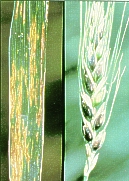
Description and Symptoms
Leaves appear initially as water-soaked spots that elongate into streaks that may extend the full length of the leaf blade. These streaks become translucent and eventually turn tan or brown. Under moist conditions, the bacteria may produce droplets that dry to a yellow, crystalline mass or that spread across the leaf surface, giving it a shellacked appearance when dry. This characteristic is an important difference between fungal and bacterial infections. Infected heads may appear blackened, greasy and chlorotic plus some kernels may be shriveled. Splashing water from rain or irrigation can spread the bacteria from diseased to healthy plants. Hail, wind, or other mechanical damage can increase infections. The bacteria have a high tolerance to temperature and moisture conditions and persists between seasons on infected seed, plant residues and some weedy grasses.
Integrated Management
Plant disease-free or the least infected seed available. Idaho research indicates bacterial levels in the seed can impact disease development. Levels can be tested in the laboratory. No resistant commercial cultivars are presently available. Avoid planting grain into infested stubble or weedy grasses. No pesticides are currently available for black chaff control. Avoid excessive and frequent irrigation, especially under sprinkler irrigation. Reduce irrigation frequency as much as possible when infected plants are damaged from hail, wind or frost to reduce the potential incidence of infection. Apply ample irrigation water to infected plants to minimize stress. However, foliage should become dry between irrigations to limit further disease development.
Impact
Take-all is a soil borne fungus, Gaeumatinomyces graminis, typically affecting barley and wheat. Influence on barley is minimal. The greatest impact can be realized after the second year of continuous wheat. Grain yield reductions can reach 60 percent. Yields are reduced, because of inhibited grain filling. Infections that occur late in the season remain confined to the roots and usually cause little damage. Take-all occurs throughout the San Luis Valley and typically develops after the second year of continuous grains.
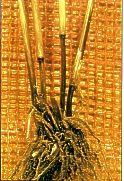
Description and Symptoms
Take-all infects the crown and roots of the plant. Severely infected plants are stunted, produce fewer tillers, ripen prematurely, and produce bleached-white heads, shriveled kernels or no seed. Symptoms become obvious at heading especially the white heads and Stunting. Severely infected plants are easy to pull out of the soil Uproot severely infected plants to reveal crown rot, severely pruned roots, and a shiny, steel-black stem surface under the lower sheaths. Black masses of mycelium are easily scraped off the base of the culms, a key characteristic. Early signs of infection are a darkness inside the roots.
Integrated Management
Rotate with non-host crops such as oats, alfalfa, or other broadleaf plants. A one-year break in small grains cultivation is sufficient to reduce soil borne innoculum levels but will not eliminate the take-all fungus. Maintain sufficient nitrogen and phosphorus fertility to encourage root and crown development. Limit soil compaction to discourage irrigation runoff and disease development. Select fertilizer materials for limiting take-all development. Nitrate-based fertilizers support take-all more than ammonium or urea fertilizers. Chloride-containing fertilizers, like potassium chloride, can limit take-all in some regions. Maintain adequate copper levels to reduce take-all. When soil levels test low, soil apply 5 to 10 pounds of copper per acre to the soil or foliar apply 0.25 pounds per acre. Avoid excessive irrigation, especially during the early part of the season. Accurate irrigation management can greatly reduce take-all infection even if all other conditions support take-all development. Limit infection of the next crop by burying crop residues through tillage. However, soil erosion potential may increase.
Impact
Loose smut is a fungus disease common wherever small grains are grown. The fungus Ustilago is the causal agent. Individual species and/or strains infect each type of small grain. Yield loss is directly related to the percentage of infected heads. Losses can range from the typical 1 percent to an entire field. Loose smut occurs throughout the San Luis Valley but typically has a limited impact. Severe cases can occur within individual fields. Disease severity depends on the infection level of the planted seed.
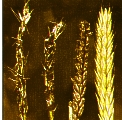
Description and Symptoms
Loose smut symptoms are not present until heading. Infected heads emerge from the boot slightly earlier than normal and are darker than healthy heads. The darkening is due to spore masses, which replace the kernels. Spore masses are covered by a thin membrane that ruptures easily after head emergence, permitting the spores to be dispersed by wind or water. After a short time, only the naked rachis remains. Loose smut is a seed borne disease. The fungus infects the developing embryo (germ) at the time of flowering. Infected seed can germinate without showing symptoms.
Integrated Management
Plant disease-free certified seed from fields inspected for loose smut. Use resistant cultivars when available. Use only systemic fungicidal seed treatments specific for treatment of loose smut. Seed-surface active fungicides are not effective. Control cannot be achieved after seed germination.
Impact
Barley yellow dwarf (BYD) is caused by several related viruses. The infection is carried and transmitted by the oak bird cherry aphid, corn leaf aphid, english grain aphid, rose grass aphid, and greenbug. The Russian wheat aphid does not transmit the barley yellow dwarf virus. Yield losses are proportional to the percentage of plants infected by the virus and the growth stage at infection. Early infection may result in high losses. All small grains can be affected by BYD. The greatest impact of BYD in the San Luis Valley is to late-planted oat hay due to the typically late arrival of aphid populations. BYD in oats is commonly called red leaf.
Description and Symptoms
The principal symptoms of BYD include leaf chlorosis, reduced root growth, and general stunting. The distinctive symptom of BYD is a bright yellowing of the leaf tips and margins and reddening in oats. Discoloration begins at the leaf tips, then enlarges toward the base of the leaf. The mid-rib area commonly stays green the longest. Severity of the infection directly affects the degree of stunting or "dwarfing." Shortened leaves and poor head development occur in severe cases.
Integrated Management
Use resistant varieties when available. Plant early to permit crop development prior to aphid flights. Avoid moisture stress and nitrogen deficiencies to ensure rapid growth and reduce the severity of BYD in infected grains. Scout for aphids in late-planted grains.
Impact
Two different rust diseases, leaf rust and barley stripe rust, occur occasionally in the San Luis Valley. Stripe rust has caused serious problems in other areas. Each rust is caused by a different species of the fungus Puccinia. Each type of grain is infected by a separate species. Barley stripe rust occurs only in barley. Leaf rust infects both wheat and barley. Wind disperses the spores. These fungi do not overwinter in the San Luis Valley. New infections depend on wind introduction each year. Rusts increase respiration and transpiration and decrease photosynthesis resulting in severe plant stress. Light infections of rust occur throughout the San Luis Valley. Serious problems are rare.
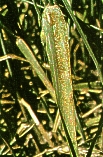 |
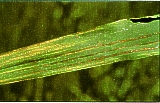 |
| Wheat Rust | Barley Stripe Rust |
Description and Symptoms
Both rusts are spread by wind-borne spores. Leaf rust appears as small, round, light orange-brown pustules scattered on leaf sheaths and blades. Leaf rust head infections are especially damaging. Stripe rust appears in barley as yellow pustules arranged as stripes on leaves, stem, and heads. Stripe rust may be very damaging if grain is infected early. Historically, infections occur only late in the season on late-planted barley.
Integrated Management
Plant resistant varieties to provide a defense against certain races of rust. Use appropriate systemic seed treatments if early season infections occur regularly. Avoid late planting (after May 15) to minimize rusts. Timely planting is especially effective to minimize barley stripe rust. Apply fungicides only in severe epidemics to protect the flag leaf.
Minor Diseases
Common Root Rot
Impact
Common root rot is caused by a complex of soil borne fungi including Helminthosporium and Fusarium species. Disease incidence occurs throughout the San Luis Valley on individual fields. Losses of stand or yield are low, ranging up to 10 percent. Disease development depends on plant stress. If soil moisture is adequate, some symptoms may be present, but the plant is more able to compensate. Light infections of common root rot occur throughout the San Luis Valley. Serious problems are rare.
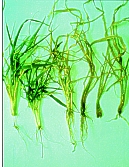
Description and Symptoms
Infected plants appear stunted, have smaller root systems, and exhibit decay in the crown area. Commonly, tillering is reduced regardless of degree of infection. Part or all of the sub-crown internode, lower nodes, crown, and roots of an infected plant usually turn brown or reddish brown. Brown coloring sometimes extends up the stem for a few internodes. Small oval brown lesions may occur on the roots and sub-crown area. Inoculum persists on cereal and grass hosts, in crop debris and in the soil. Some fungi can exist for months in the soil without a host.
Integrated Management
Rotate out of wheat or barley for one year to reduce fungal inoculum levels in the soil. Oats or broad leaf crops are suitable rotation crops. Plant resistant cultivars when available. Avoid soil compaction and provide good soil tilth to limit seedling stress. Plant early at a proper seeding depth to permit uniform germination and emergence under cooler soil temperatures, which delay common root rot infections. Maintain adequate nitrogen and phosphorus levels to encourage vigorous root and shoot growth, enabling plants to resist or tolerate infection. Avoid plant moisture stress through accurate irrigation management.
Impact
Net Blotch, caused by Pyrenophora teres (the perfect stage of Helminthosporium), occurs occasionally in the San Luis Valley. Net blotch affects only barley and oats by reducing the carbohydrate content and the malt extract for brewing. Serious infections reduce yield and quality. Light infections of net blotch occur through out the San Luis Valley. Serious problems are rare.
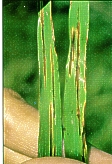
Description and Symptoms
Net blotch lesions first appear as light brown patches with a pattern of dark brown inside them. The dark brown pattern of net blotch lesions takes on a net-like pattern characteristic of the disease. Surrounding areas become yellow. Net blotch lesions can spread over an entire leaf and kill it. The fungus overwinters on seed or on plant residue in the soil. Net blotch is most common in cool weather and can be found from early growth stages through maturity. Severe attacks occur mainly after flag leaf emergence causing premature leaf death. Wet weather provides favorable conditions for disease development. Lush vegetative growth can encourage disease development.
Integrated Management
Rotate out of barley two years to reduce inoculum in the soil. Eliminate surface crop residue to help reduce net blotch. Plant resistant varieties when available. Avoid excessive nitrogen rates that cause lush vegetative growth favoring net blotch development. Decrease irrigation frequency to allow foliage to dry between irrigations. Apply fungicides in severe cases especially to protect the flag leaf.
Impact
Powdery mildew is caused by the fungus Ersiphe graminis, which affects the foliage and heads of small grains. Each type of small grain is infected by a separate subspecies. The disease damages plants by competing for plant nutrients, destroying leaf surfaces, reducing plant photosynthesis, and increasing plant respiration and transpiration rates. Serious economic loss is rare from powdery mildew due to typically low humidity in the San Luis Valley despite the higher humidity under sprinkler irrigation. Light infections of powdery mildew occur throughout the San Luis Valley. Serious problems are rare.
Description and Symptoms
White, cottony patches of the fungus initially form on the upper surfaces of lower leaves. The patches can spread to all aerial portions of the plant. Opposite sides of an infected leaf may become pale green to yellow. The patches turn dull gray or brown with age and develop dark specks. Dense plant stands, heavy nitrogen fertilization, lush growth, high humidity, and cool temperatures favor disease development. Overwintering occurs on crop residue. In the spring, inoculation occurs by wind-borne spores. Manage crop to limit excessive vegetative growth (i.e., proper fertilizer levels) to limit disease development.
Integrated Management
Use crop rotation to reduce disease inoculum from crop residue, Plant resistant varieties when available. Resistance depends on the strain of the fungus. Apply systemic foliar fungicides only for severe infestations.
Impact
Species of the fungus Septoria cause Septoria leaf blotch. Reduced seed set, poor seed filling and shriveled grain are common concerns when a Septoria outbreak is severe. Septoria inhibits grain filling by reducing photosynthesis and increasing respiration. Losses are greatest when the flag leaf is affected. Septoria leaf blotch has not been a serious problem in the San Luis Valley. Low levels of leaf blotch do not affect yields significantly.
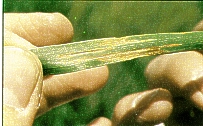
Description and Symptoms
Look for symptoms of Septoria leaf blotch when prolonged periods of damp weather occur. The disease may affect plants at any stage of development under a wide range of temperatures. Symptoms are water-soaked or yellowish spots or specks that first appear on the lower leaves. Large areas of leaves may be affected. Symptoms spread to upper foliage and glumes if wet conditions persist. As lesions develop, dark specks appear in their centers. The specks are a key diagnostic feature of Septoria leaf blotch. Septoria survives on infected crop residue, volunteer grain and seed. Spores are produced on the surface of infected stubble or crop residue under damp conditions. Splashing water or wind move spores to the surfaces of leaves. Spores begin to germinate and infect if the leaf surface remains continuously wet for at least 6 hours. Greater infection occurs when foliage remains wet for two or three days.
Integrated Management
Plant resistant cultivars when available. Early maturing cultivars are more susceptible in some regions. Manage crop residue to minimize inoculum after serious infestations. Rotate crops to limit inoculum survival. Manage crop to limit excessive vegetative growth (i.e., proper fertilizer). Apply foliar fungicides when Septoria leaf blotch outbreaks threaten to infect the flag leaves.
Impact
Russian wheat aphids (RWA), Diuraphis noxia, are a localized problem in the San Luis Valley. In other areas RWA is a very serious problems and requires regular control measures. Aphids are brought in from other areas by winds. RWA infestations are more frequent in the eastern and southern areas of the San Luis Valley. Oats are resistant to RWA. Triticale is moderately resistant, but damage can still occur. Wheat is susceptible and barley is the most susceptible. Heavy infestations may cause severe yield losses. Yields can be reduced by 50 percent. RWA does not transmit viruses.
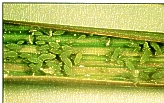
Description and Symptoms
RWA are pale green, long, and spindle-shaped (football like) with no visible cornicles. Antennae are short compared with other aphid species. A projection above the tail gives Russian wheat aphids a two-tailed appearance. Colonies of aphids are produced inside rolled small grain leaves. RWA secrete a toxin that causes white or purple streaks on the leaves. Purple discoloration is more common in cool weather, while white streaks and leaf rolling are more prominent in warm weather. Heads of infested plants may become twisted and distorted and may not emerge. Some heads may emerge in a fish hook shape. Infestations can spread rapidly. As the colonies become crowded or the plant declines, wingless aphids can move to neighboring plants. Winged forms may also disperse and infest other fields.
Integrated Management
Plant as early as possible. Plant resistant cultivars when available. Maintain a healthy grain crop to avoid plant stress that can cause greater aphid susceptibility. Scout suspect fields weekly for early detection. Estimate the economic threshold for wheat based on the following:
Wheat before Flowering:
Percent Infested Tillers =Control Costs per Acre x 200/Expected Crop Value per Acre
Wheat After Flowering:
Percent Infested Tillers =Control Costs per Acre x 500/Expected Crop Value per Acre
Barley threshold is probably lower due to grain quality effects. Select contact and systemic insecticides labeled for control.
Impact
High populations of aphids other than RWA can occur but seldom require treatment. Impact varies with an aphid species and plant growth stage. Natural predators generally control aphid populations.
Description and Symptoms
Aphids feed on the plant carbohydrates and can damage the flag leaf and grain head. Research in North and South Dakota and in Minnesota suggests aphid damage may be critical at late growth stages. Aphid feeding commonly creates a sticky substance or "honeydew." Typical aphids of the San Luis Valley include:
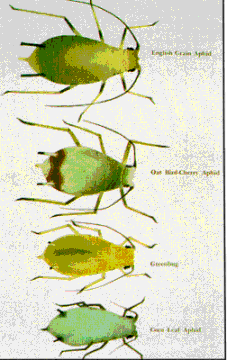 |
English Grain Aphid Oak Bird Cherry Aphid Green Bug Corn Leaf Aphid |
Integrated Management
Scout fields regularly when aphid populations appear. Conserve natural enemies that control aphids Use the following chart or economic thresholds to decide when to treat aphids other than the RWA with a pesticide.
| Average Number of Aphids per Plant | |||||
| Type of Aphid | Seedling | Boot to Heading | Flowering | Milky Ripe | Milk to Medium Dough |
| Greenbug | 5 - 15 | 25 | > 25 | > 25 | > 25 |
| Corn Leaf Aphid | 20 | 30 | > 25 | > 25 | > 25 |
| Oat bird Cherry Aphid | 20 | 30 | 5 | 10 | >10 |
| English Grain Aphid | 30 | 50 | 5 | 10 | >10 |
Impact
Armyworms, Pseudaletia unipuncta, can occasionally cause severe damage to crops throughout the San Luis Valley. This insect prefers grass crops, including small grains, but will feed on some broadleaf crops such as potatoes after grain maturity. The greatest threat in small grains is head clipping in barley.

Description and Symptoms
Mature larvae are about 1 1/2 inches in length, smooth-bodied, and dark grey ,to greenish-black in color. They are characterized by five stripes, three on the back and two on the sides, running the length of the body. The stripes on the sides are pale orange with a white outline. The head capsule is remarkable for its honeycomb of black markings. Dense vegetation is preferred for egg laying. Newly hatched larvae move with a looping (inchworm) action. Larvae feed at night and on cloudy days, and hide under crop debris during sunny periods. Several generations can occur per year with the first damage occurring very early in the growing season. Larvae overwinter in upper layers of the soil or under crop debris. Population increases are dramatic from a single hatch, which is a serious threat to neighboring fields. The new larvae may feed and move together like an army. Crop damage can range from early season seedling destruction to late season clipped heads. Larvae feed on green plant material throughout the season. Head clipping is more common in barley. Large flocks of blackbirds in a grain field have been noted in the San Luis Valley as an indication a high population of army cutworms.
Integrated Management
Scout often for armyworm in field margins, low areas with rank growth, or areas of lodged plants. Look for feeding damage, droppings around base of plant, or dropped plant material. Check for larvae in and under debris, around damaged plants and in heads of barley or wheat. Treat armyworm infestations if all of the following conditions are met:
1) larval counts exceed action threshold
2) worms are 3/4 to 1 1/4 inches in length
3) most larvae are not parasitized (look for white eggs behind the head or small brown cocoons attached to the body)
4) leaf feeding or head clipping is evident.
| Situation | Action threshold |
| Small grains (preheading, defoliation in lower leaves) | 5 larvae per square foot |
| Small grains (head clipping) | 2 larvae per square foot |
Pyrethroid insecticides are the most effective at control.
Impact
Army cutworms, Euxoa auxiliaris, can feed on a wide range of plants. Greatest concern is with small grains and alfalfa.
Description and Symptoms
Army cutworms overwinter as larvae. Larvae can be active at low temperatures (40 degrees F). Larvae pupate in early spring. Adults emerge and lay eggs in late summer and fall. Adults are commonly referred to as miller moths. Larvae are pale gray and splotched with light markings. The upper body is lighter colored with a dark strip down the middle of the back. A light strip runs along the sides. Larvae grow to 1 1/2 to 2 inches long. Larvae will climb a plant to reach green vegetation. When green vegetation is scarce in the spring, army cutworms will devour entire small grain seedlings. This is a common indication of a serious population. Regrowth of damaged seedlings can occur if green matter is present and the crown is not damaged. However, seedling damage is rare.
Integrated Management
Scout until grain maturity. Protect natural predators which can control moderate populations. Apply insecticides when populations are high, two to four larvae per square foot. Pyrethroid insecticides are the most effective, but spraying is rarely necessary.
Note: This information should only be used as a guide. Adjustments for local conditions must always be made.